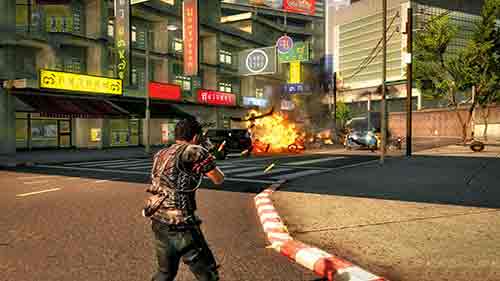
#Just cause 2 pc controlls code#
Something that bears mentioning is that the code I’m working with is pre-final. Worth noting that, while it’s very hard to grab comparison screenshots of these, they do look lovely on any setting. After 30 minutes or so, I didn’t feel the need to do so. And, again, you can redefine them if you really want to. Some of the controls take some getting used to for newcomers to Just Cause – right-click is used for your grapple and tethers rather than for aiming, for instance – but these quirks are understandable considering the game’s focus. Likewise, even the options menus above demand a weird hybrid of mouse and keyboard to control: you pretty much have to use the keyboard to scroll down through options, but the selected option always defaults to whatever the mouse cursor is on. Hitting 1 to open the map and associated menus feels bizarre, and the same goes for using 2 and 3 to move between tabs. Clicking and dragging to move the map often results in an accidental click on one of the buttons at the top of the screen. Surprisingly, despite a lot of the game’s tech clearly being built for PC, the menus and maps are definitely built for gamepads.Īll of the keybinds for these are redefinable, but I still haven’t really found a comfortable way of setting things up. Just Cause 4 controls just fine on mouse and keyboard, except for one area: the general user interface. Vsync may fix this, but you can also see it in an in-game scene below. There’s also some really odd stuff that seems like frame interpolation: it mostly crops up in the in-game cutscenes, but it can make walking characters look almost like they’re vibrating. Grass and other purely visual bits of the environment fade in and out as you get nearer, being replaced by higher-quality stuff, and it looks almost like a wave racing ahead of you, gradually changing the details. No matter the LOD Factor (which I’m assuming is the relevant option here), it’s very easy to see details changing at a distance as you wingsuit over the landscapes. You also can’t see some of the slightly odder visual effects in these screenshots. Just look at that close-up of Rico’s face, especially in low detail. Character hair, in particular, is something that just looks very wrong throughout. Close-up textures aren’t great across the board, and while vistas tend to be spectacular, there are a few quirks when it comes to stuff that’s nearby. “But Tim,” you cry, “even if it’s more scalable than a tiny hillock, how does it look?” Don’t worry, voice in my head! I have you covered due to the magic of comparison screenshots.ĭespite it looking pretty lovely either way, there’s definitely an emphasis on making everything look nice at a distance rather than close up.

Yes, there is a specific section in the controls for cranes. But I do want to quickly highlight the controls: The other options aren’t quite so spectacular, mostly being what you’d usually expect (mouse sensitivity, subtitles, various audio levels). Motion Blur is something that every game should allow you to disable because it is effectively the devil, and the rest of the scalability is pretty bloomin’ decent too. Graphics, first:Īll in all, a pretty good set of options. OptionsĪs is tradition, we’ll start off by looking at the options. We’ll get onto specifics when we talk about comparisons, but Just Cause 4 ran better than plenty of other games with lower recommended specs.
#Just cause 2 pc controlls 1080p#
After all, most recommended specs are aimed at 1080p gaming, and it’s rare to see a high-end GeForce as a “recommended” card.Īnd yet, that’s not quite what happened. When the recommended specs include a GeForce 1070 and a processor that’s slightly in advance of my own, I fully expect things to move like a nailed-down sloth when I’m running things at 2560×1440. I’m not going to lie: those Just Cause 4 system specs terrified me. Graphics: GeForce GTX 1070 (6GB) / AMD Vega 56 (6GB).Processor: Intel Core i7-4770 3.4 GHz / AMD Ry 3.2 GHz.



 0 kommentar(er)
0 kommentar(er)
